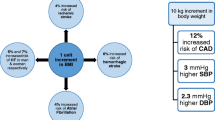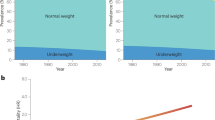Abstract
Obesity has assumed epidemic proportions and is expected to decrease the life expectancy of current and future generations by its cardiovascular complications and other associated chronic diseases. Recognizing the gravity of this trend, the American Heart Association recently identified obesity as an independent and important modifiable risk factor for cardiovascular disease. Obesity is known to cluster with other cardiovascular and metabolic risk factors constituting the cardiometabolic syndrome. The pathophysiogic link between obesity and cardiovascular disease is complex and involves multiple metabolic and inflammatory risk factors. In an attempt to better elucidate this major public health problem, this article reviews obesity as an epidemic, the structural and functional changes in the cardiovascular system as a result of obesity, and the pathophysiology of obesity-related cardiomyopathy. The sheer magnitude of the problem of obesity with its immense cardiovascular consequences warrants immediate intervention.
Similar content being viewed by others
References and Recommended Reading
Ogden CL, Carroll MD, Curtin LR, et al.: Prevalence of overweight and obesity in the United States, 1999–2004. JAMA 2006, 295:1549–1555.
Whitaker RC, Wright JA, Pepe MS, et al.: Predicting obesity in young adulthood from childhood and parental obesity. N Engl J Med 1997, 37:869–873.
Olshansky SJ, Passaro DJ, Ronald C, et al.: A potential decline in life expectancy in the United States in the 21st century. N Engl J Med 2005, 352:1138–1145.
Eckel RH, Kahn R, Robertson RM, Rizza RA: Preventing cardiovascular disease and diabetes: a call to action from the American Diabetes Association and the American Heart Association. Circulation 2006, 113:2943–2946.
Galasssi A, Renolds K, He J: Metabolic syndrome and risk of cardiovascular disease: a meta-analysis. Am J Med 2006, 119:812–819.
Mokdad AH, Bowman BA, Ford BA, et al.: The continuing epidemics of obesity and diabetes in the United States. JAMA 2001, 286:1195–1200.
World Health Organization: Overweight and obesity; fact sheet 311. Available at http://www.who.int/mediacentre/factsheets/fs311/en/index.html. Accessed November 30, 2007.
Weiss R, Dziura J, Burgert TS, et al.: Obesity and the metabolic syndrome in children and adolescents. N Engl J Med 2004, 350:2363–2374.
Li TY, Rana JS, Manson JE, et al.: Obesity as compared with physical activity in predicting risk of coronary heart disease in women. Circulation 2006, 113:499–506.
Van Gaal LF, Mertens IL, De Block CE: Mechanisms linking obesity with cardiovascular disease. Nature 2006, 444:875–880.
Wong C, Marwick TH: Obesity cardiomyopathy: pathogenesis and pathophysiology. Nat Clin Pract Cardiovasc Med 2007, 4:436–443.
Kenchaiah S, Evans JC, Levy D, et al.: Obesity and the risk of heart failure. N Engl J Med 2002, 347:305–313.
Chiu HC, Kovacs A, Ford DA, et al.: A novel mouse model of lipotoxic cardiomyopathy. J Clin Invest 2001, 107:813–822.
Szczepaniak LS, Dobbins RL, Metzger GJ, et al.: Myocardial triglycerides and systolic function in humans: in vivo evaluation by localized proton spectroscopy and cardiac imaging. Magn Reson Med 2003, 49:417–423.
Iacobellis G, Corradi D, Sharma AM: Epicardial adipose tissue: anatomical, biomolecular and clinical relation to the heart. Nat Cardiovasc Clin Pract Med 2005, 2:536–543.
Wong CY, O’Moore-Sullivan T, Leano R, et al.: Alterations of left ventricular myocardial characteristics associated with obesity. Circulation 2004, 101:3081–3087.
Peterson LR, Waggoner AD, Schechtman KB, et al.: Alterations in left ventricular structure and function in young healthy obese women: assessment by echocardiography and tissue Doppler imaging. J Am Coll Cardiol 2004, 43:1399–1404.
Lastra G, Manrique C, Whaley-Connell A, Sowers J: Hypertension and the cardiometabolic syndrome. J Clin Hypertens 2005, 7:471–476.
Okamoto E, Couse T, De Leon H, et al.: Perivascular inflammation after balloon angioplasty of porcine coronary arteries. Circulation 2001, 104:2228–2235.
Safar M, Levy B, Striker-Brodier H: Current perspective on arterial stiffness and pulse pressure in hypertension and cardiovascular diseases. Circulation 2003, 107:2864–2869.
Montani JP, Carroll JF, Dwyer TM, et al.: Ectopic fat storage in heart, blood vessels and kidneys in the pathogenesis of cardiovascular diseases. Int J Obes Relat Metab Disord 2004, 28(Suppl 4):S58–S65.
Després JP, Lemieux I: Abdominal obesity and metabolic syndrome. Nature 2006, 444:881–887.
Xu H, Barnes GT, Yang Q, et al.: Chronic inflammation in fat plays a crucial role in the development of obesity-related insulin resistance. J Clin Invest 2003, 112:1821–1830.
Cancello R, Henegar C, Viguerie N, et al.: Reduction of macrophage infiltration and chemoattractant gene expression changes in white adipose tissue of morbidly obese subjects after surgery-induced weight loss. Diabetes 2005, 54:2277–2286.
Bujalska IJ, Kumar S, Stewart PM: Does central obesity reflect “Cushing’s disease of the omentum”? Lancet 1997, 349:1210–1213.
Ishii T, Masuzaki H, Tanaka T, et al.: Augmentation of 11beta-hydroxysteroid dehydrogenase type 1 in LPS-activated J774.1 macrophages—role of 11beta-HSD1 in pro-inflammatory properties in macrophages. FEBS Lett 2007, 581:349–354.
Cooke JP, Oka RK: Does leptin cause vascular disease? Circulation 2002, 106:1904–1905.
Rahmouni K, Haynes WG, Mark AL: Cardiovascular and sympathetic effects of leptin. Curr Hypertens Rep 2002, 4:119–125.
Mattioli B, Straface E, Quaranta MG, et al.: Leptin promotes differentiation and survival of human dendritic cells and licenses them for Th1 priming. J Immunol 2005, 174:6820–6828.
Knudson JD, Dincer UD, Zhang C, et al.: Leptin receptors are expressed in coronary arteries, and hyperleptinemia causes significant coronary endothelial dysfunction. Am J Physiol Heart Circ Physiol 2005, 289:H48–H56.
Soderberg S, Ahren B, Stegmayr B, et al.: Leptin is a risk marker for first-ever hemorrhagic stroke in a population-based cohort. Stroke 1999, 30:328–337.
Soderberg S, Ahren B, Jansson JH, et al.: Leptin is associated with increased risk of myocardial infarction. J Intern Med 1999, 246:409–418.
McTernan PG, McTernan CL, Chetty R, et al.: Increased resistin gene and protein expression in human abdominal adipose tissue. J Clin Endocrinol Metab 2002, 87:2407–2410.
Reilly MP, Lehrke M, Wolfe ML, et al.: Resistin is an inflammatory marker of atherosclerosis in humans. Circulation 2005, 111:932–939.
Hotamisligil GS, Arner P, Caro JF, et al.: Increased adipose tissue expression of tumor necrosis factor-alpha in human obesity and insulin resistance. J Clin Invest 1995, 95:2409–2415.
Mousa SA: Elevation of plasma von Willebrand factor and tumor necrosis factor-a in obese subjects and their reduction by the low molecular weight heparin tinzaparin. Int Angiol 2005, 24:278–281.
Kern PA, Di Gregorio GB, Lu T, et al.: Adiponectin expression from human adipose tissue: relation to obesity, insulin resistance, and tumor necrosis factor-alpha expression. Diabetes 2003, 52:1779–1785.
Ouchi N, Kihara S, Arita Y, et al.: Novel modulator for endothelial adhesion molecules: adipocyte-derived plasma protein adiponectin. Circulation 1999, 100:2473–2476.
Kumada M, Kihara S, Ouchi N, et al.: Adiponectin specifically increased tissue inhibitor of metalloproteinase-1 through interleukin-10 expression in human macrophages. Circulation 2004, 109:2046–2049.
Ma LJ, Mao SL, Taylor KL, et al.: Prevention of obesity and insulin resistance in mice lacking plasminogen activator inhibitor 1. Diabetes 2004, 53:336–346.
Xiang G, Schuster MD, Seki T, et al.: Down-regulation of plasminogen activator inhibitor 1 expression promotes myocardial neovascularization by bone marrow progenitors. J Exp Med 2004, 200:1657–1666.
Appel SJ, Harrell JS, Davenport ML: Central obesity, the metabolic syndrome, and plasminogen activator inhibitor-1 in young adults. J Am Acad Nurse Pract 2005, 17:535–541.
Hamsten A, de Faire U, Walldius G, et al.: Plasminogen activator inhibitor in plasma: risk factor for recurrent myocardial infarction. Lancet 1987, 2:3–9.
Mohamed-Ali V, Goodrick S, Rawesh A, et al.: Subcutaneous adipose tissue releases interleukin-6, but not tumor necrosis factor-alpha, in vivo. J Clin Endocrinol Metab 1997, 82:4196–4200.
Smith SR, Wilson PW: Free fatty acids and atherosclerosis—guilty or innocent? J Clin Endocrinol Metab 2006, 91:2506–2508.
Pilz S, Scharnagl H, Tiran B, et al.: Free fatty acids are independently associated with all-cause and cardiovascular mortality in subjects with coronary artery disease. J Clin Endocrinol Metab 2006, 91:2542–2547.
Giacchetti G, Faloia E, Mariniello B, et al.: Overexpression of the renin-angiotensin system in human visceral adipose tissue in normal and overweight subjects. Am J Hypertens 2002, 15:381–388.
Janke J, Engeli S, Gorzelniak K, et al.: Mature adipocytes inhibit in vitro differentiation of human preadipocytes via angiotensin type 1 receptors. Diabetes 2002, 51:1699–1707.
Lijnen P, Petrov V: Antagonism of the renin-angiotensin system, hypertrophy and gene expression in cardiac myocytes. Methods Find Exp Clin Pharmacol 1999, 21:363–374.
Keaney JF, Larson MG, Vasan RS, et al.: Obesity and systemic oxidative stress: clinical correlates of oxidative stress in the Framingham Study. Arterioscler Thromb Vasc Biol 2003, 23:434–439.
Hayden MR, Stump CS, Sowers JR: Introduction: organ involvement in the cardiometabolic syndrome. J Cardiometab Syndr 2006, 1:16–24.
Furukawa S, Fujita T, Shimabukuro M, et al.: Increased oxidative stress in obesity and its impact on metabolic syndrome. J Clin Invest 2004, 114:1752–1761.
Brunner H, Cockcroft JR, Deanfield J, et al.: Endothelial function and dysfunction. Part II: association with cardiovascular risk factors and diseases. A statement by the Working Group on Endothelins and Endothelial Factors of the European Society of Hypertension. J Hypertens 2005, 23:233–246.
Author information
Authors and Affiliations
Corresponding author
Rights and permissions
About this article
Cite this article
Karuparthi, P.R., Yerram, P., Govindarajan, G. et al. Obesity and cardiovascular risk. Curr Cardio Risk Rep 2, 113–119 (2008). https://doi.org/10.1007/s12170-008-0022-3
Published:
Issue Date:
DOI: https://doi.org/10.1007/s12170-008-0022-3




